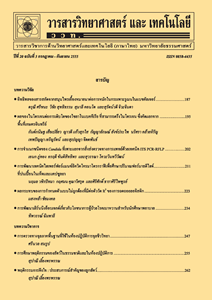แบคทีเรียที่เพาะเลี้ยงได้จากเพลี้ยจักจั่น (Yamatotettix flavovitatus) พาหะนำโรคใบขาวอ้อย
Main Article Content
Abstract
บทคัดย่อ
การศึกษาชนิดของแบคทีเรียที่สามารถเพาะเลี้ยงได้จากเพลี้ยจักจั่นหลังขาว (Yamatotettix flavovitatus) พาหะนำโรคใบขาวอ้อย เพื่อคัดเลือกนำไปใช้ควบคุมแมลงแบบชีววิธี โดยแยกแบคทีเรียให้เจริญบนอาหารเลี้ยงเชื้อ nutrient agar จำแนกชนิดโดยวิเคราะห์ลำดับนิวคลีโอไทด์ของยีน 16S rRNA จากการวิเคราะห์ตัวอย่างจำนวน 29 โคโลนี พบแบคทีเรียจาก 6 อันดับ 13 สกุล 22 ชนิด คัดเลือกแบคทีเรีย 3 ไอโซเลท คือ Arthrobacter woluwensis YF-01, Bacillus subtilis YF-01 และ Bacillus megaterium YF-01 มาทดสอบการก่อให้เกิดโรค โดยให้เพลี้ยจักจั่นหลังขาวดูดกินแบคทีเรียที่ความเข้มข้น 1x109 cell/ml เป็นเวลา 72 ชั่วโมง พบว่ามีเปอร์เซ็นต์ การตาย 16.67-26.67 % และตรวจสอบการแพร่กระจายตัวของแบคทีเรียที่คัดเลือกในเพลี้ยจักจั่นและในต้นอ้อยด้วยเทคนิค PCR พบว่าทั้งสามชนิดสามารถตรวจพบในทุกระยะการเจริญตั้งแต่ ไข่ ตัวอ่อน และตัวเต็มวัย และตรวจพบในตัวอย่างต้นอ้อยที่เป็นพืชอาหาร จากงานวิจัยนี้สามารถคัดเลือกชนิดของแบคทีเรียที่คาดว่ามีความเป็นไปได้ในการนำไปประยุกต์ใช้ในการควบคุมแมลงพาหะแบบไม่ใช้สารเคมี
คำสำคัญ : เพลี้ยจักจั่นหลังขาว (Yamatotettix flavovitatus); โรคใบขาวอ้อย; แบคทีเรีย
Abstract
This study was to identify the cultivable bacteria from leafhopper Yamatotettix flavovitatus vector of sugarcane white leaf disease for biological control approach. The isolated bacteria were cultured on Nutrient agar and identified by analysis of 16S rRNA gene sequence. Twenty nine bacterial colonies were classified into 6 order 13 genus and 22 species. Three isolates including Arthrobacter woluwensis YF-01, Bacillus subtilis YF-01 and Bacillus megaterium YF-01 were selected to test for their pathogenicity. After feeding the leafhopper with those bacteria at 1x109 cell/ml for 72 hrs, the mortality rate was 16.67-26.67 %. The prevalence of these bacteria in the leafhopper and sugarcane was tested by PCR. They were distributed in both sugarcane and all developmental stages of insect vector. These three isolated bacteria might be possible to be used as a biological control agent against leafhopper in the future.
Keywords: leafhopper (Yamatotettix flavovitatus); sugarcane white leaf disease; bacteria


